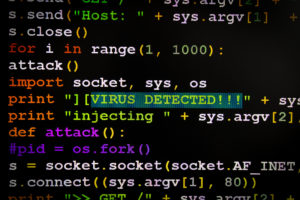Cost-sensitive steps to help the biggest sector of cybercrime victims develop their defenses.
Bottom Line: Small to mid-sized businesses are the largest percentage victims of cyber predator attacks. The reason is simple: Most small- to mid-sized businesses have not prioritized the job of equipping their business with sufficient IT security. This makes small- to mid-sized businesses easy targets for cyber criminals.
Request a Network Health Check
or
Request a Review of a Sample Health Check Report
Inadequate Protection from Major Cybercrime
Three factors contribute to this:
- because there needs to be better education about what IT vulnerabilities look like.
- because IT security solutions can cost a lot of money, and it is hard for decisionmakers to know how much of those investment dollars should be put into IT development instead of product development
- because there is a lot of ignorance about how devastating a cyber attack can be, and
how close every business is to a major cyber-attack every moment of every day.
Cyber criminals will take from you:
- Intellectual property (either hold it for ransom or use it for profit)
- Payment card data (monetary theft)
- Personal ID information (identity theft)
Here is a no-nonsense list of the biggest threats that would cost your company potentially thousands, or millions, of dollars ($2,235,00 average pricetag for the average mid-sized business, according to Ponemon’s 2017 Cybersecurity Report).
Cyber Predator Attack #1: Email attachments
The 2018 Symantec report on security threats still puts email at the top of the list at 88%. Opening that email that looks like it is from someone you know, but is really a cybercriminal in disguise, and then opening that attachment, which is really a destructive piece of malware that will take over your data files, still reigns supreme. Anyone can accidentally misjudge an email that is made to masquerade.
How to protect yourself:
Email filters. Not all email filters are the same. Find one that gives you its money’s worth. Have an IT professional help you find a competent solution for the needs of your business.
Cyber Predator Attack #2: Accessing a Business Network via Remote Access
Small businesses tend to be careful how they spend their outsourcing dollars; understandable. It is difficult to know when you are paying for a substandard service. In the world of IT outsourcing, the cheaper company might actually be a source of infection. How is that possible? By the way your IT service performs remote support. Not all remote management systems are secure. Cyber criminals can use the vulnerabilities of weak remote management systems to deliver ransomware into your network.
How to protect yourself:
Get a secure remote access management solution. Make any IT company you consider provide you with a full explanation of the remote access management system they employ. Have them explain to you the protocols in place for remote access, and how they ensure the security of the remote access environment.
Cyber Predator Attack #3: Fileless Attacks/Browser Hijacking
Have you ever felt compelled to check out that link to see the “25 Most Amazing Destinations” for some cool vacation spots? As you are going through the slide show of destinations, did you notice your computer’s fan starts whirring at a high rate of speed? Chances are good that you are experiencing a browser hijacking. The hijacking may be limited to this one browser session, or the hijacking may be able to take up more permanent residence in your computer. Of course, close your browser if you experience this.
While all your employees are busy at their work stations, an open browser can lead to data destruction for your business. Maybe ransomware, or maybe your computer has been made a drone for a cyber criminal, busy spending lots of YOUR energy and using YOUR data processing as a cryptominer. Tech gurus who predict future security threats expect that 35% of this year’s attacks will be the fileless/browser hijacking sort, and that they will be growing to become a more dominant attack approach for the future. Why? Because this approach is proving to be very successful for the cyber criminal. By and large, businesses are not protecting themselves from this kind of attack.
How to protect yourself:
Get Advanced Malware Protection. There are several products that provide ongoing protection against threats that could lurk in the background of your network. Cisco is one of the go-to brands Secure Networkers tends to use. Moreover, businesses have the opportunity of experiencing demos to “try before you buy” an advanced malware protection solution and do a proper cost/benefit analysis on it.
 Who is attacking you right now?
Who is attacking you right now?
Chances are good that you have bad guys robbing your business of time, energy, or information via your computer network right now.
How to protect yourself:
Get A Security Assessment. A proper IT service can provide a complete analysis of what is going on with your system right now, help interpret both the results of the analysis and how to eradicate the threats. This will help you become well informed on how to prevent future attacks.
Backup! If you lose data because of a cyber criminal, it can only be because you failed to sufficiently keep all your data backed up in a reliable system. Simply having an offsite backup service is not considered a sufficient backup plan. You do not want to find this out the hard way.
The threat is real. The risk of neglecting IT security is very high. The cost that comes from a data breach can be more than you can ever pay. Any step you take towards a more secure IT environment is a step in the right direction, and the step that could prevent big trouble for your small-to mid-sized business.



Recent Comments